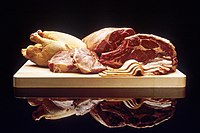
Photo from wikipedia
Eighty Dorper × thin-tailed Han cross-bred non-castrated male lambs [mean body weight (BW), 25.87 ± 1.06 kg] were randomly allocated to one of five different concentrations of slow-release urea (urea phosphate, UP). The feed consisted… Click to show full abstract
Eighty Dorper × thin-tailed Han cross-bred non-castrated male lambs [mean body weight (BW), 25.87 ± 1.06 kg] were randomly allocated to one of five different concentrations of slow-release urea (urea phosphate, UP). The feed consisted of an equal amount of concentrate diet and roughage; the concentrate feed was formulated to be isoenergetic and isonitrogenic and contained 0%, 1%, 2%, 4% and 8% UP (UP0.0, UP1.0, UP2.0, UP4.0 and UP8.0, respectively) as a replacement for soya bean meal. Feed intake, BW, average daily gain (ADG), feed utilisation efficiency (FUE), absolute and relative organ weights and biochemical and histopathological parameters were measured. Feed intake, BW, ADG and FUE significantly decreased in the group receiving UP8.0 (p < 0.05), but no difference was found among the other groups (p > 0.05). Quadratic equations were developed between the UP dosage in the concentrate feed and ADG or FUE (r2 = 0.973 for ADG and r2 = 0.761 for FUE) to determine the appropriate dosage of UP given the desire to maximise either ADG or FUE, the appropriate dosage (feed concentration) was calculated as 2.01% UP to achieve the greatest ADG or 2.13% UP to achieve the best FUE. The relative weight of the liver (% BW) in the UP2.0 groups was significantly greater than that of UP0.0 (p < 0.05), and the relative weight of the intestine in the UP8.0 was significantly greater than that of UP0.0 (p < 0.05); the relative weight of the carcass, heart, spleen, lung, kidney, rumen, reticulum, omasum and abomasum did not differ among treatments (p > 0.05). The UP8.0 treatment significantly increased serum phosphorus levels (p < 0.05) and decreased the levels of alkaline phosphatase, glucose and calcium (Ca) compared with the lower UP dosage (p < 0.05). No histopathological differences were found in either hepatic tissues or renal tissues among treatments. Dietary UP as a replacement for soya bean in concentrate feeds for mutton sheep should not exceed 4%, as higher dosing may cause malnutrition and mineral disorders.
Journal Title: Journal of Animal Physiology and Animal Nutrition
Year Published: 2017
Link to full text (if available)
Share on Social Media: Sign Up to like & get
recommendations!